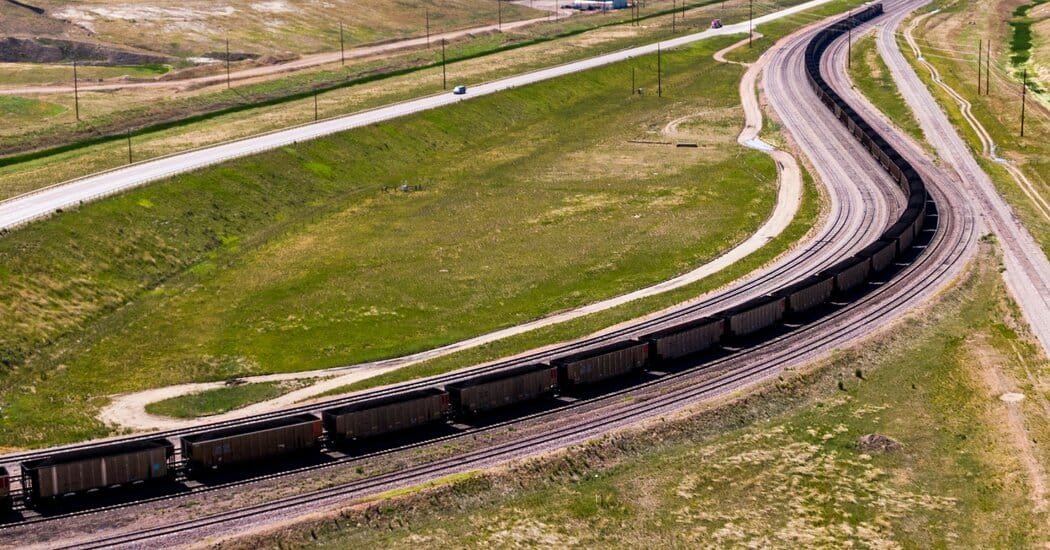The Biden administration’s move on Thursday to strictly limit pollution from coal-burning power plants is a major policy shift. But in many ways it’s one more hairpin turn in a zigzag approach to environmental regulation in the United States, a pattern that has grown more extreme as the political landscape has become more polarized.
Nearly a decade ago, President Barack Obama was the Democrat who tried to force power plants to stop burning coal, the dirtiest of the fossil fuels. His Republican successor, Donald J. Trump, effectively reversed that plan. Now President Biden is trying once more to put an end to carbon emissions from coal plants. But Mr. Trump, who is running to replace Mr. Biden, has promised that he will again delete those plans if he wins in November.
The country’s participation in the Paris climate accord has followed the same swerving path: Under Mr. Obama, the United States joined the global commitment to fight climate change, only for Mr. Trump to pull the U.S. out of it, and for Mr. Biden to rejoin. If Mr. Trump wins the presidency, he is likely to exit the accord. Again.
Government policies have always shifted between Democratic and Republican administrations, but they have generally stayed in place and have been tightened or loosened along a spectrum, depending on the occupant of the White House.
But in the last decade, environmental rules in particular have been caught in a cycle of erase-and-replace whiplash.
“In the old days, the regulatory days of my youth, we were going back and forth between the 40-yard lines,” said Douglas Holtz-Eakin, who directed the nonpartisan Congressional Budget Office and now runs the American Action Forum, a conservative research organization. “Now, it’s back and forth between the 10-yard lines. They do it and undo it and do it and undo it.”
Economists and business executives say this new era of sharp switchbacks makes it difficult for industries to plan. If there is anything that companies like less than government regulation, it is an unstable business climate.
“If the regulatory changes are just whiplash or snapback, it creates a level of uncertainty that makes it very hard to build a vibrant economy,” said Marty Durbin, senior vice president for policy at the U.S. Chamber of Commerce, the nation’s largest business lobby.
“It’s not about the specific regulation or the specific candidate,” Mr. Durbin said. “We’ve got to have more long-term certainty about how business is going to be regulated.”
The hairpin turns can lead to lost investments, said Mr. Holtz-Eakin, as companies pay to comply with one rule (for example, by shutting down coal plants or building new electric vehicle factories) and end up with sunk costs as the rules are rolled back, only for the rules to be restored four years later, often with new details, timelines and technical requirements.
“Change is costly,” Mr. Holtz-Eakin said. “Even deregulation carries a cost. Doing and undoing these rules four times means four times the cost.” He estimated the cost of the whiplash to the economy to be at “easily billions and billions of dollars.”
The cycle of enacting and erasing environmental rules limits their capacity to protect the environment, Mr. Holtz-Eakin said.
In the past four months, the Biden administration has strengthened or restored rules that Mr. Trump had deleted, including regulations to cut greenhouse emissions from cars and oil and gas wells; to limit the pollution of toxic coal ash; to protect the habitat of the sage grouse and other endangered species; and to tighten safety controls at chemical plants. All of these rules are likely to be weakened or rolled back once again under a new Trump administration.
Mr. Biden has made those actions a hallmark of his administration from his first day in office. On that day, he rescinded the permit for the Keystone XL oil pipeline, which Mr. Obama had rejected but Mr. Trump had later revived. Mr. Biden also ordered federal agencies to review and reinstate more than 100 environmental regulations that Mr. Trump had watered down or removed.
“We’re going to combat climate change in a way we have not before,” Mr. Biden said that day, calling for a whole-of-government approach in which agencies across the federal government, from the U.S.D.A. to the Pentagon, enact policies to address global warming.
The escalation of climate change as a defining crisis of the century has made it a highly visible target for Mr. Trump, who has called global warming “a hoax.” He has promised to promote fossil fuels and destroy regulations designed to limit their emissions, which are dangerously heating the planet.
A nearly 1,000-page “battle plan” for the first 180 days of a new Republican administration, written in part by former senior energy and environment officials from the former Trump administration, targets multitudes of environmental rules for rollback. It also pointedly sums up an overarching philosophy: “The Biden administration’s climate fanaticism will need a whole-of-government unwinding.”
Some economists have sought to measure the economic impacts of climate regulation whiplash.
Costas Gavriilidis, who teaches at the University of Stirling in Scotland, developed a U.S. Climate Policy Uncertainty Index charting the federal government’s wild swings on climate policy. He said he was inspired to create the index after watching incredulously from abroad as the U.S. joined, left, and then rejoined the Paris climate agreement in just over five years.
His research shows that whenever the index shoots up to about 50 points, it creates an economic shock of such magnitude that it leads to a 1.5 percent decrease in industrial production, a 0.4 percent increase in unemployment, a 2 percent increase in commodity prices and a 0.4 percent increase in consumer prices, reflecting the fact that producers incorporate the risk of higher production costs associated with uncertain climate policy into their prices.
Since the Trump presidency, Mr. Gavriilidis’s index has remained at its highest levels.
“All of these regulations are occurring in industries where capital is really important — capital to generate power, abate pollution, invest in a long pipeline of research and development,” said Steve Cicala, co-director of the National Bureau of Economic Research’s Project on the Economic Analysis of Regulation. “If in the future the regulations end up not being binding, then these companies have just wasted a bunch of money.”
Automakers agree. During the Obama administration, major auto companies complained about the cost of meeting tough limits on tailpipe pollution that were designed to speed up the adoption of nonpolluting electric vehicles. After investing in energy-efficient, hybrid and electric vehicles, auto executives asked Mr. Trump to slightly loosen the rules — but not to roll them back entirely. Mr. Trump, however, did just that.
Last month, Mr. Biden reinstated and expanded the limits on tailpipe emissions, something Mr. Trump says he will reverse if he returns to office.
But auto companies grudgingly say they want the rules to stay. One major reason: Automakers are now designing the vehicles they will put in showrooms by 2028, said John Bozzella, president of the Alliance for Automotive Innovation, which represents 42 car companies that produce nearly all of the new vehicles sold in the U.S. Manufacturing vehicles requires an upfront capital investment, and companies must decide this year how many gasoline, hybrid and all-electric cars and trucks to produce.
“If that planning is happening now and I make a decision anticipating that three or four years from now there will be an emissions constraint, but then by the time the model is on the market the constraint is gone, then I’ve lost money,” Mr. Bozzella said. “All of a sudden you’ve changed the rules. What am I supposed to do? Change the plant? Retool the plant? And that has direct consequences on jobs along the supply chain.”
Martin Fischer is president of the Americas division of ZF Group, a global manufacturer that builds auto parts and technology systems for cars made by General Motors, Ford and Stellantis at plants in Michigan, Wisconsin, Georgia and elsewhere. He said his company is hedging its bets in order to navigate the regulatory uncertainty around electric vehicles in the U.S.
Last year, the company spent $500 million to convert a plant in Gray Court, S.C., so that it could build transmissions for internal combustion engines as well as for hybrids and all-electric vehicles. “We are preparing product offerings for E.V.s, but we are planning for swings back and forth,” Mr. Fischer said. “Regulatory clarity would make us more bullish. We would take more risks and invest more money.”
After the Obama administration required oil companies to detect and stop leaks of methane, a greenhouse gas that often seeps from pipes and drilling sites, major companies like BP, Shell and Exxon Mobil asked Mr. Trump to maintain the essence of the regulation. Nonetheless, Mr. Trump gutted it. Late last year, Mr. Biden restored and strengthened it. Now that rule, too, is expected to be targeted if there is another Trump administration — even though oil executives say they want it to remain.
Jim Magagna, a Wyoming sheep rancher and executive vice president of the Wyoming Stock Growers Association, said he had been buffeted by the wildly different policies from the various administrations toward protecting the sage grouse, a bird that nests in a habitat that stretches across 11 Western states and exists only in the continental U.S. Scientists estimate its population has declined by about 90 percent because of mining, drilling and cattle grazing.
To protect the bird, whose health is an indicator of the overall health of its sprawling habitat, the Obama administration limited where drilling, mining and grazing could occur. In 2017, the Trump administration opened up protected sage grouse areas for drilling and grazing. Last month, the Biden administration proposed several ways to reinstate the protections but did not make a final decision.
The uncertainty looms over Mr. Magagna. He doesn’t know whether to change where his cattle grazes or invest $20,000 to build fences and watering holes in new grazing areas.
“They are undoing things just to say they undid their predecessors without a thought to the people who live on the ground and have to go through this,” he said.
That sentiment echoes across the American economy, Mr. Holz-Eakin said. “In terms of the behavior and outcomes you’ll get in the private sector, this is the worst way to run a railroad.”













